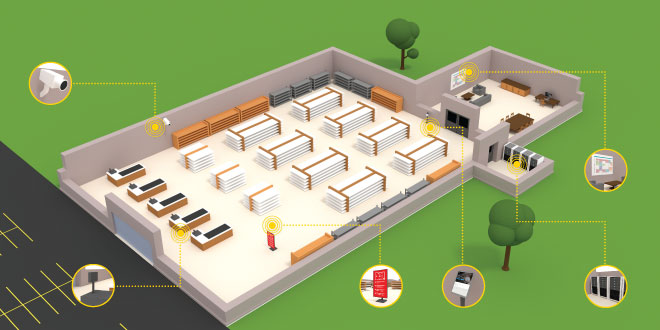To view a PDF of this story, click here.
Picture it: A customer walks into your store and receives an alert on his phone about a special on charcoal for his grill. He received the alert because he purchased a grill from you in the spring.
He picks up the charcoal, talks with an employee about a few other items he needs, and works with the employee to pay right there in the plumbing aisle, without waiting in line, using his phone and a mobile payment app.
The receipt is emailed to him, and it’s in his inbox before he reaches his car.
Or how about this? Before you leave home, you take a look at your store’s work management app on your tablet. You notice some items your store manager added to the to-do list, which he has assigned to a few employees who will be working that day. You remember a couple more things that need to be taken care of, and you add them to that to-do list before you head out the door to get to work.
By the time you walk in the doors of your store, your manager has assigned out those tasks, and several employees are hard at work completing each one (in between helping customers, of course).
Two of your newer employees are spending any down time working on the next couple of modules in your training app, making sure they are up-to-date with product knowledge and store procedures. They’re using their phones to study these modules, allowing them to stay near the salesfloor and ready to help a customer at any moment.

Do these sound like scenarios you’d like to replicate? With today’s smart technology, it’s entirely possible that these what-if situations can become a reality.
Using smart home technology to make a home more efficient and secure is a popular topic with consumers right now.
In the same vein, there are many technologies available today that can make your store more efficient, more secure and more profitable.
And now, you can use that technology to create a better customer experience and streamline your day-to-day operations.
On the following pages, we’ll look at how one forward-thinking retailer is using innovative technologies in multiple areas of his business, and we’ll talk with industry experts who are on the cutting edge of some of the tools available to retailers today.
Visit TheRedT.com/smart-store-video to find a video that further details what you can do in each of the six different areas—loss prevention, payment, smart marketing, employee training, data security and operations—we discuss in this story.
Keep in mind that you don’t have to be a larger retailer with multiple locations to incorporate these high-tech ideas, as many of them are scalable.
Even trying an app to help all employees work together to manage and complete a daily to-do list can be a good start, and that requires no more than downloading the app (which is often free, or costs only a few dollars) and setting it up for your team to use.
As technology changes the retail landscape, it’s important that you look for ways to bring technology into your own store so you stay relevant to your customers, and stay competitive in the years ahead.
Loss Prevention
You know it’s important to keep an eye on security at your store, whether you’re protecting against shrinkage or false customer claims. But smart store technologies can help you streamline your security. You can put in a full-store system, or you can get started quickly and inexpensively with one or two old smartphones.
Chris Miller, president of Parker’s Building Supply, which has 24 locations in Texas and California, uses his security cameras to do more than prevent shrinkage. “We can also use them to keep an eye on what’s going on in the store and to counter false claims customers may raise.”
He says most of his business locations have camera systems, and he has an app on his phone that allows him to check any of the cameras.
“Ten years ago, I don’t think we had a single camera. The initial purchase of our current system was expensive, but what we’ve been able to see in the store and how we’ve been able to use them has made them worth the investment,” Miller says.
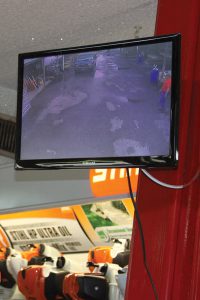 And the cameras do more than help prevent shrinkage. He says they’ve helped if a customer makes a claim about something that may or may not have happened at the store. “Unfortunately, there have been times when customers falsely accuse us of something. Now, we can go back and verify what happened. Those false claims would have cost us a lot of money had we not been able to prove otherwise. Our cameras have paid for themselves 10 times over.”
And the cameras do more than help prevent shrinkage. He says they’ve helped if a customer makes a claim about something that may or may not have happened at the store. “Unfortunately, there have been times when customers falsely accuse us of something. Now, we can go back and verify what happened. Those false claims would have cost us a lot of money had we not been able to prove otherwise. Our cameras have paid for themselves 10 times over.”
Security cameras are becoming less costly and more effective, as prices drop and camera quality and storage capacity increases. “It’s a big win for everyone,” says Sam Kirkland, strategic relationship manager for Epicor Software Corporation. Wireless systems are easier to install, and the ability to check the camera feed from a smartphone or tablet means you can quickly check what’s going on in the store. That could be particularly convenient if, for example, the alarm system goes off and you need to check if the alarm is false or valid.
If you don’t want to buy a camera, there is a way to modify an old smartphone so it becomes a security camera. Just download a security camera app—there are a variety available for both Apple and Android devices—and then mount the camera wherever you choose.
When it comes to monitoring your store, also consider linking your POS system to your camera security system. This setup is useful in catching any potential employee fraud at the register.
“A lot of retailers have a POS that can feed into the security system, so you can overlay what is happening visually at the cash station with the transaction that is being rung up at the POS,” Kirkland says. “You can watch the video and connect the POS transaction to the video. This helps catch employee fraud and helps resolve a lot of issues.
“With the higher storage capacity, you can capture and save a lot more footage than before,” he says. “So where before you could only hold three or four days of security footage, now you can hold a month’s worth.”
Payment
The future of payment can be summed up in one word: mobile. Whether it’s mobile payment or mobile checkout stations, as technology continues to develop, the checkout process should be faster, and lines should be shorter.
With mobile payment, customers can use retailer-specific apps to pay for their purchases. One company making the most of their own app is one you may visit daily: Starbucks.
Many Starbucks customers pay for their coffee and other drinks through the app, with no cash or credit card needed. They can use the app to pre-load money into their Starbucks account, and then scan their phone at the checkout counter.
If you don’t have your own app, or don’t want to create one, no problem: You can use one like Apple Pay or Android Pay. Both allow customers to pay via their smartphones, simply by scanning their phones at checkout.
Not sure if you are on board with the idea of mobile payments? The reality is that customers will soon be demanding it, even in the next year or two, says Kirkland. “When the consumer is educated on the security of mobile payments, they will demand it, and will drive changes in retail.”
This method of payment is more secure than other types of credit card transactions and allows more flexibility and protection to both retailers and customers.
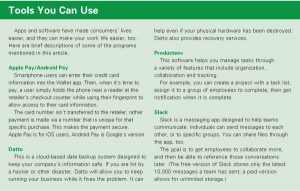
Mobile pay stations continue to be popular as well. There are a variety of apps—one of the most popular is Square—that allow customers to swipe their cards somewhere other than at the checkout counter.
Many point of sale (POS) systems may come with a mobile pay station program, which allows you to provide mobile payments. Check with your POS vendor to see if it has one you may be able to use.
Mobile pay stations can be particularly helpful in lumberyards, where customers want to load and then pay from their vehicles, or for customers in the lawn and garden department, who may have larger purchases to load.
“This is all about customer service, too,” Kirkland says. “For that customer, the price of the bag of mulch isn’t as important as the fact that you’re loading it for them and they don’t have to leave their car.”
Eventually, he says, POS systems could steer away from PCs and turn into docking stations for tablets. “Tablet technology is advancing such that the need for laptops is going down and tablet use is going up. You can use the tablet as a monitor, and it will give you the information you need.”
Smart Marketing
Websites are becoming less important as apps become more important, Kirkland says. “Yes, you still need a website, but websites aren’t enough anymore. In the future, an app—snippets of information that help to accomplish a specific task—is what a retailer needs to have.”
As you consider looking for an app that will best serve your store’s needs, or perhaps even creating your own customized app, ask yourself: “What am I trying to accomplish?”
If you want to build an app for your store, think about what you’d like to focus on. Maybe you’d like to offer coupons and other forms of savings, or make customers aware of specials. Perhaps you do quite a bit of online business and want to offer your customers a way to easily order online. Or maybe you simply want a quick reference guide to allow customers to find your contact information or get directions to your store.
But when it comes to capturing the shoppers’ attention, beacons are the next big thing. A beacon is a small piece of hardware placed in strategic locations throughout the store. It connects directly to smartphones through Bluetooth.
With beacon technology, you can send messages to customers via smartphone when they walk by a beacon’s location. For example, say you’re having a sale on small appliances. A small beacon near the housewares department would transmit messages to customers who went by, and they’d receive alerts on their phones letting them know about the sale.
Alerts can also be customized based on shoppers’ previous purchases, so for example those who had previously purchased housewares from you might get messages from that department. Beacons may also be able to generate real-time data, including the areas of the store shoppers frequent the most.
You can take this data and change store layouts as needed to better accommodate the flow of shoppers throughout the store.
One of the challenges of beacon technology is that consumers must opt in to receive these messages. “It cannot track you unless you allow it to,” Kirkland says.
It’s also important to consider your average transaction size to make sure you will get your money’s worth if you invest in beacon technology.
Beacon technology has only been around for a few years, but the price is dropping, making it more accessible to more retailers. In fact, Apple, PayPal and other big names have, or are in the process of, creating their own forms of this beacon technology.
Another upcoming trend is augmented reality, where videos or graphics are overlaid on a real-world environment, such as the popular Pokémon Go, says Steve Koenig, senior director of market research for the Consumer Technology Association.
In fact, Koenig references the Pokémon Go craze as a perfect example of the success of augmented reality. “Pokémon Go is arguably the first mass adopted augmented reality application, and it’s more than proven that the concept is a successful one among consumers.”
He predicts different forms of augmented reality will become more popular in retail sectors, especially around the holidays. “It’s no surprise that the first successful example is a game, a form of entertainment, but now the groundwork has been laid for businesses to find out how they can make augmented reality work for them.”
While you may not have the resources to create an augmented reality game, you can embrace what’s already on the market and find a way to use it to your advantage. A good example is retailers who have invited Pokémon Go players into their stores, boosting exposure to their businesses.
“More and more brands are selling experiences, and that’s just what this is,” he says.
Any way you can get the customer more involved and interacting with your products is helpful. One example, says Koenig, is a retailer who sells headphones, and may set up a POP display that connects to Bluetooth so customers can test the headphones with music from their library on their phone.
Customer loyalty programs remain another effective way to market to a group of targeted customers by reaching out to them and offering sales and discounts based on past purchases. When done correctly, target marketing based on data derived from a loyalty program can drive many more customers into your store.
Employee Training
Offering employees high-quality training experiences can be the difference in their ability to offer good customer service, or to offer great customer service.
Again, mobile devices are powerful tools. Remember those scenarios we discussed earlier, and how one included some new employees working on modules on a training app? While employees can work at computer workstations as they do their training, another option is to allow them to access training from a smartphone or tablet.
The advantage here is that they take a closer look at products on the shelves as they boost their product knowledge, or walk to different displays throughout the store as they learn about the importance of strong merchandising.
Many customers get information online about products or projects before they come in to your store. It’s a good idea to have information from some of your biggest brands and best-selling products at the ready.
“Customers can watch YouTube videos and learn how to do something, but I think the customer expectation, when they come in to the store, is that the retailer should have even more information,” says Koenig. “There may be opportunities to use training apps from manufacturers of the brands you sell in your store.
“You can curate for your staff five or so training apps from manufacturers, and assign them the responsibility of going through them and familiarizing themselves with them,” he says. “Then, when the customer has a question, it’s easy for the employee to answer right away, or to find the answer in the app.”
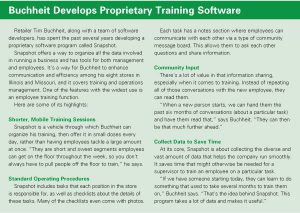
Rather than see smartphones as a distraction, think of them as tools that help employees become better at their jobs and help customers find the products and knowledge they are looking for.
If you don’t want your employees to keep their phones on them during their shifts, you might consider purchasing some work-only tablets and have them available at the store to be used for training.
By having that mobile technology, employees can open up their YouTube app and show a customer a how-to video, or visit a manufacturer’s website to pull up product information, right there in the aisle as they look at the product with the customer.
Data Security
With these advances in technology comes the necessity of keeping your data safe.
“It’s not the most exciting investment for a business to make, but obviously people care about their personal information and the privacy surrounding it,” Koenig says. “People don’t even think about it sometimes, but we are generating and collecting more data than ever before. Keeping your customers safe should be a priority—make sure you are up to industry standards and have the necessary best practices in place.”
It’s a best practice to make regular backups of your server and keep a copy of your data offsite as well as onsite.
But cloud technology has made data protection much easier today than in years past.
After hackers compromised his company database—during the middle of an audit—Miller implemented a cloud backup site so that it was easy to restore his data if he was ever hacked again (and he was).
“We used to have a server at a corporate office where data from all of the stores would go, but now we’ve moved that to a third-party facility in a very secure location, that’s backed up regularly and safe from hurricanes or other natural disasters that are frequent in this area,” says Miller.
“We have a lot more at stake if a server goes out; it could take out the data for multiple stores,” he says. “You don’t know how much stuff you have on your computer until you lose it all.”
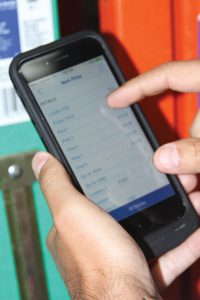 Some of the more popular cloud storage systems include Google Drive, Amazon Cloud Drive, Datto, Dropbox and Box. Most of these systems come with different tiers—the more storage you require, the more you pay per month. There’s usually a free version with a limited amount of storage that you can start with, which offers you an opportunity to try out the system and see if it’s right for you.
Some of the more popular cloud storage systems include Google Drive, Amazon Cloud Drive, Datto, Dropbox and Box. Most of these systems come with different tiers—the more storage you require, the more you pay per month. There’s usually a free version with a limited amount of storage that you can start with, which offers you an opportunity to try out the system and see if it’s right for you.
Most cloud systems come with smartphone and tablet apps as well to make it easy for you to manage your storage on the go.
And operating from the cloud also means the software you currently use, such as your POS or accounting programs, is stored in the cloud rather than on your local computer or device, so it’s quicker and easier to make any updates, which can be done automatically.
“There are a lot of benefits to operating on a cloud-based system,” says. Kirkland. “One is that IT requirements can be lessened, because there is no software in your store. If it’s time to make a change in the software, those updates can be made instantly. There’s no waiting until the store is closed, and no taking a disk to all of the computers after hours and waiting for updates. The cloud has made the update process easier.”
It’s also easier to fix any problems that may arise with cloud-based storage, Kirkland says. Many hosting systems have a full IT department on staff, which means they usually fix problems quickly, resulting in less down time than there would be if you were trying to fix the problem yourself.
Operations
One of the best ways to ensure an operation runs smoothly and employees manage their time efficiently is through good communication. And using smart technology can help.
Again, apps are an easy way to use technology to quickly and efficiently accomplish a specific task. There are plenty of apps available that help employees communicate and share information. Slack and Trello are two examples of apps with this function. If you’re looking for an app to use, look for one that allows employees to communicate well (even across locations) and coordinate to-do lists.
You can also look for apps that offer more specialized functions. For example, the Shyft app allows employees to swap work shifts as needed.
Want to make it easier to receive inventory each week when your truck arrives? Some brands have begun labeling merchandise with HFID tags, which works with sensors you can install in your warehouse, Koenig says. The two work together to automatically scan product as it is physically moved into your warehouse or back room, saving your employees the time of manually scanning everything.
The catch? You must have the sensors installed in your store, and your vendors must have the compatible tags.
Check with some of your popular brands and see if they offer this technology. “Some brands have started using this technology as they work with big-box stores, and would most likely be able to use the same technology with independent retailers,” Koenig says.
There are also many ways to use technology to monitor and enhance the performance of your business. Miller relies on a Compass dashboard, which is a function of his POS system and allows him to track key performance indicators all in one place. He has the dashboard on his phone so he can quickly see what’s happening at any of his stores.
“My manager dashboard has 30 different KPIs (key performance indicator) that we track,” says Miller. “These are easy to read and have those key indicators that we preset and easily show where a store needs work.”
Many POS systems can perform functions like these. Talk with your POS provider and see if they have a setup that meets your needs.
Miller says the technology allows everyone across the company to share best practices.
“For example, if the company manager who manages shrink sees something at one store that needs fixed, he can send it to everyone else so they can check it in their store as well,” he says.
Miller and his management team currently use an app called Producteev on their phones. This task management app allows Miller or any managers to glance at a variety of data—anything from the store’s past productivity numbers to a list of tasks that need to be done.
“If I’m in the store and see something that needs to be addressed, I can take a photo of it, then task the manager with fixing the problem,” he says. “The next time I’m in the store, I can bring up the list and check off each one to be sure they’re done.”
The Producteev app is for the company’s district managers, to keep everyone on the same page, Miller says. For example, if a district manager gives a store manager a task to do in his store, he can forward it to other stores as well.
“It’s a tool to share good ideas and create more consistency within the locations,” Miller says.
They’re currently developing a new customized app, which will be a store audit tool as they walk the store. “It’s an easy checklist with a to-do list for each store manager,” Miller says. “Parker’s Building Supply has a minimum standard for customer experience, and this allows the district manager to monitor that, to monitor the health of the store.”
Finally, he’s installing fingerprint scanners to replace the current time clock software. “The fingerprint method will make it faster for employees to clock in and out, and it keeps them honest,” he says. “The new system will be costly to implement, but the long-term savings will outweigh the cost.”
Hardware Retailing staffers Liz Lichtenberger and Jesse Carleton contributed to this article.
 Hardware Retailing The Industry's Source for Insights and Information
Hardware Retailing The Industry's Source for Insights and Information



